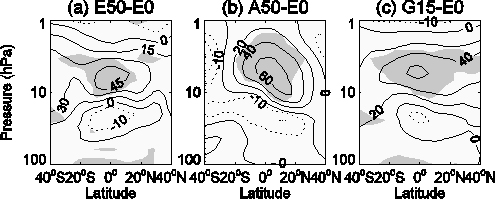Effect of Methane Emission Increases in East Asia on Atmospheric Circulation and Ozone
Date:2015-10-19
Chinese scientists have proven that when methane (CH4) emissions increase by the same amount in East Asia and North America, the effects on atmospheric circulation and ozone (O3) are different. The study was published in Advances in Atmospheric Sciences.
The effects of an increase in CH4 concentration on atmospheric radiation and chemistry have been extensively studied. However, the chemistry–radiation–dynamic interactions associated with CH4 increases have not been resolved well in previous modeling studies, largely due to the limitation of model performance in the stratosphere. Additionally, while most previous studies have investigated the effects on climate and stratospheric O3 of global-scale CH4 emission increases, the less well-studied effect of a CH4 emissions increase in East Asia on global temperature and O3 remains a popular but controversial issue.

Fig. 1. Latitude–height cross sections of the O3 differences (units: ppbv) when (a) CH4 emissions increase by 50% in East Asia, (b) CH4 emissions increase by 50% in North America, and (c) CH4 emissions increase by 15% on the global scale, relative to the control experiment (E0). Shaded regions show where the differences are statistically significant at the 90% confidence level, using the Student’s t-test.
Using a fully coupled chemistry–climate model (WACCM3), the study, led by Dr. LIU Yi, under a collaboration among the Institute of Atmospheric Physics/CAS, Lanzhou University, and Shandong Provincial Climate Centre, shows that the Brewer–Dobson circulation in the tropics between 10°S and 10°N at 100 hPa weakens as CH4 emissions increase in East Asia, but strengthens when CH4 emissions increase in North America.
When CH4 emissions increase by 50% in East Asia and North America, the maximum increase of stratospheric O3 is 45 ppbv and 60 ppbv, respectively (Fig. 1). So, a CH4 emissions increase in North America has a greater influence on the stratospheric O3 than the same CH4 emissions increase in East Asia.
When CH4 emissions increase in East Asia, the increase in the tropospheric O3 concentration is largest in August. When CH4 emissions increase in North America, the increase in the O3 concentration is largest in July in the mid-troposphere, and in April in the upper troposphere.
Reference:
Shang, L., Y. Liu, W. S. Tian, and Y. L. Zhang, 2015: Effect of methane emission increases in East Asia on atmospheric circulation and ozone. Adv. Atmos. Sci., 32(12), 1617–1627, doi: 10.1007/s00376-015-5028-4.
